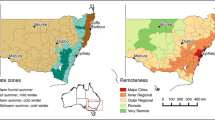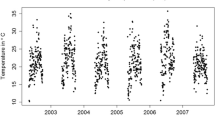Abstract
Objectives
To determine and characterise the health impacts of extreme heat events on the population in five regions of New South Wales (NSW). Such data provide evidence necessary for the development of policy and programme initiatives designed to reduce the burden of disease due to the impact of climate change.
Methods
A case-only approach was used to analyse 1,497,655 emergency hospital admissions in Sydney East and West, Illawarra, Gosford-Wyong and Newcastle. The distribution of daily minimum and maximum temperatures in each region was used to define extreme heat (≥99th percentile). We investigated the susceptibility of the main causes of emergency hospital admission to extreme heat. We also examined the presence of underlying conditions as a risk modifier of emergency hospital admission on extreme heat. Logistic regression model was used to estimate the effect modifications.
Results
Main causes: On days of extreme heat, the risk of emergency hospital admission due to heat-related injuries, dehydration and other disorders of fluid, electrolyte and acid–base balance increased more than the risk of admission from other causes. Underlying conditions: Those with underlying mental and behavioural disorders, diseases of nervous and circulatory system, especially cardiac, diseases of respiratory system, especially asthma and chronic obstructive pulmonary disease, neoplasms and renal disease, especially renal failure, were more susceptible to an extreme heat event.
Conclusions
In this study, we identified several main diagnoses and underlying conditions for emergency hospital admission that are particularly susceptible to extreme heat events. This knowledge can contribute directly to establishing health programmes that would effectively target those with higher relative risk of emergency hospital admission due to extreme heat.

Similar content being viewed by others
References
Armstrong BG (2003) Fixed factors that modify the effects of time-varying factors: applying the case-only approach. Epidemiology 14:467–472
Bernard SM, McGeehin MA (2004) Municipal heatwave response plans. Am J Public Health 94(9):1520–1522
Department of Health (2009) Heatwave-plan for England, protecting health and reducing harm from extreme heat and heatwaves Available at: http://www.dh.gov.uk/prod_consum_dh/groups/dh_digitalassets/documents/digitalasset/dh_099583.pdf
Diaz J, Jordan A, Garcia R et al (2002) Heat waves in Madrid: 1986–1997: effects on health of the elderly. Int Archiv Occup Environ Health 75(3):163–170
Filleul L, Cassadou S, Medina S et al (2006) The relation between temperature, ozone, and mortality in nine French cities during the heat wave of 2003. Environ Health Perspect 114:1344–1347
Garcia-Pina R, Tobias GA, Sanz NJ, Navarro SC (2008) Effect of weather temperature on hospital emergencies in the Region of Murcia, Spain, throughout the 2000–2005 and its use in epidemiological surveillance. Revista Espanola de Saud Publica 82(2):153–166 Wolfgong Ahrens and Iris Pigeot Handbook of Epidemiology
Hajat S, Armstrong B, Baccini M et al (2006) Impact of high temperatures on mortality: is there an added heat wave effect? Epidemiology 17:632–638
Hales S, Samond G, Town GI, Kjellstrom T, Woodward A (2000) Daily mortality in relation to weather and air pollution in Christchurch, New Zealand. Aust J Public Health 24(1):89–91
Hansen A, Bi P, Nitschke M, Ryan P et al (2008) The effect of heatwaves on mental health in a temperate Australian city. Environ Health Perspect 116:1369–1375
Johnson H, Kovats RS, McGregor G, Stedman J, Gibbs M, Walton H (2005) The Impact of the 2003 heat wave on daily mortality in England and wales and the use of rapid weekly mortality estimates. Eurosurveillance 10:7–9 Jul-Sep
Josseran L, Caillere N, Brun-Ney D, Rottner J et al (2009) Syndromic surveillance and heat wave morbidity a pilot study based on emergency departments in France. BMC Med Inform Decis Mak 9:14
Kaiser R, Le Tetre A, Schwarz J et al (2007) The effect of the 1995 heat wave in Chicago on all-cause and cause-specific mortality. Am J Public Health 97(suppl 1):S158–S162
Kalkstein L, Valamont K (1986) An evaluation of summer discomfort in the United States using a relative climatological index. Bull Am Meteorol Soc 67:842–848
Kalkstein L, Jamason P, Greene J et al (1996) The Philadelphia hot weather-health watch warning system: development and application, Summer 1995. Bull Am Meteorol Soc 77:1519–1528
Keatinge WR, Donaldson GC, Bucher K, Jendritsky G, Cordioli E, Martinelli M et al (1997) Cold exposure and winter mortality from ishaemic heart disease, cerebrovascular disease, respiratory disease, and all causes in warm and cold regions of Europe. Lancet 349(9062):1341–1346
Kilbourne EM (2002) Heat related illness: current status of prevention efforts. Am J of Prev Med 22i:328–329
Kovats RS, Ebi KL (2006) Heatwaves and public health in Europe. Eur J Pub Health 16:592–599
Kovats RS, Hajat S, Wilkinson P (2004) Contrasting patterns of mortality and hospital admissions during hot weather and heat waves in Greater London. Occup Environ Med 61:893–898
Le Tertre A, Lefranc A, Eilstein D, Declercq C, Medina S, Blanchard M, Chardon B, Fabre P, Filleul L, Jusot JL, Pascal L, Prouvost H, Cassadou S, Ledrans M (2006) Impact of the 2003 heatwave on all-cause mortality in 9 French cities. Epidemiology 17:1
Linares C, Diaz J (2007) Impact of high temperatures on hospital admissions: comparative analysis with previous studies about mortality (Madrid). Eur J of Pub Health 18(3):3312–3322
Martin-Latry K, Goumy MP, Latry P, Gabinski C et al (2007) Psychotropic drugs use and risk of heat-related hospitalisation. Eur Psy 22(6):335–338
Mastrangelo G, Hajat S, Fadda E, Buja A et al (2006) Contrasting patterns of hospital admissions and mortality during heat waves: are deaths from circulatory disease a real excess or an artefact? Med Hypotheses 66(5):1025–1028
Mastrangelo G, Fedeli U, Visentin C, Milan G et al (2007) Pattern and determinants of hospitalisation during heat waves: an ecologic study. BMC Public Health 7:200
Medina-Ramon M, Zanobetti A, Cavanagh DP, Schwartz J (2006) Extreme temperatures and mortality: assessing effect modification by personal characteristics and specific cause of death in a multi-city case-only analysis. Environ Health Perspect 11:1331–1336
Michelozzi P, Accetta G, De Sario M, D’Ippoliti D et al (2009) High temperature and hospitalizations for cardiovascular and respiratory causes I n12 European cities. Am J Resp Crit Care Med 179(5):383–389
Nitschke M, Tucker GR, Peng B (2007) Morbidity and mortality during heatwaves in metropolitan Adelaide. MJA 187(11/12):662–665
Nogueira PJ (2005) Examples of heat health warning systems: Lisbon’s ICARO surveillance system, summer 2003. In: Kirch W, Menne B, Bertollini R (eds) Extreme weather events and public health responses. Springer, Berlin, pp 141–160
O’Neill MS, Zanobetti A, Schwart J (2003) Modifiers of temperature and mortality association in seven US cities. Am J Epidemiol 157:1074–1082
O’Neill MS, Hajat S, Zanobetti A et al (2005) Impact of control for air pollution and respiratory epidemics on the estimated associations of temperature and daily mortality. Int J Biometeorol 50:121–129
Saez M, Sunyer J, Castellsague J et al (1995) Relationship between weather temperature and mortality: a time series analysis approach in Barcelona. Int J Epidemiol 24:576–582
Schwartz J (2005) Who is sensitive to extremes of temperature? A case-only analysis. Epidemiology 16:67–72
Semenza JC, McCullough JE, Flanders WD, McGeehin MA et al (1999) Excess hospital admissions during the July 1995 heat wave in Chicago. Am J Prev Med 16(4):269–277
Sheridan S, Kalkstein LS (2004) Progress in heat watch-warning system technology. Bull Am Meteorol Soc 85:1931–1941
Shiloh R, Shapira A, Potchter O, Hermesh H et al (2005) Effects of climate on admission rates of schizophrenia patients to psychiatric hospitals. Eur Psy 20:61–64
Smoyer-Tomic KE, Rainham DGC (2000) Beating the heat: development and evaluation of a Canadian Hot Weather Health Response Plan. Environ Health Perspect 109:1241–1247
Solomon S, Qin D, Manning M, Chen Z, Marquis M, Averyt K B, Tignor M and Miller H L (2007) IPCC fourth assessment report (AR4). Climate change 2007: the physical science basis. Contribution of working group I to the fourth assessment report of the intergovernmental panel on climate change. Cambridge University Press, Cambridge, United Kingdom and New York, NY, USA, p. 996
Stafoggia M, Forastiere F, Agostini D et al (2006) Vulnerability to heat-related mortality: multicity, population-based, case-crossover analysis. Epidemiology 17:315–323
Acknowledgments
We would like to acknowledge the support and assistance of the Australian Bureau of Meteorology and the New South Wales Department of Environment, Climate Change and Water. We would like to thank Professor Bin Jalaludin from University of New South Wales and Associate Professor Geoff Morgan from University of Sydney, for reviewing this paper and their comments. We would also like to thank Mr Sina Mavaddati from Department of Planning for preparing the map. This research was part of the NSW Health Department Climate Change Adaptation Programme and funded under the NSW Government’s Climate Change Adaptation Research Fund.
Conflict of interest statement
The authors declare they have no competing financial interests.
Author information
Authors and Affiliations
Corresponding author
Rights and permissions
About this article
Cite this article
Khalaj, B., Lloyd, G., Sheppeard, V. et al. The health impacts of heat waves in five regions of New South Wales, Australia: a case-only analysis. Int Arch Occup Environ Health 83, 833–842 (2010). https://doi.org/10.1007/s00420-010-0534-2
Received:
Accepted:
Published:
Issue Date:
DOI: https://doi.org/10.1007/s00420-010-0534-2




